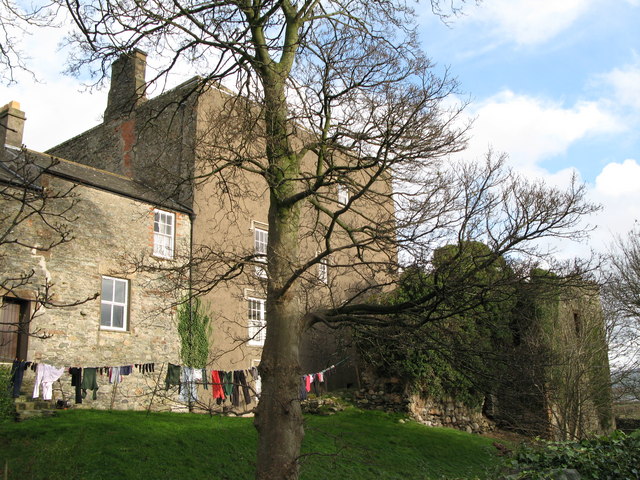Millom Castle on:
[Wikipedia]
[Google]
[Amazon]
 Millom Castle is an ancient building at
Millom Castle is an ancient building at
 Millom Castle is an ancient building at
Millom Castle is an ancient building at Millom
Millom is a town and civil parish on the north shore of the estuary of the River Duddon in southernmost Cumberland, Cumbria, England. It is situated just outside the Lake District National Park, about north of Barrow-in-Furness ( by road) and ...
in Cumbria
Cumbria ( ) is a ceremonial county in North West England. It borders the Scottish council areas of Dumfries and Galloway and Scottish Borders to the north, Northumberland and County Durham to the east, North Yorkshire to the south-east, Lancash ...
. It is a Grade I listed building
In the United Kingdom, a listed building is a structure of particular architectural or historic interest deserving of special protection. Such buildings are placed on one of the four statutory lists maintained by Historic England in England, Hi ...
and scheduled ancient monument
In the United Kingdom, a scheduled monument is a nationally important archaeological site or historic building, given protection against unauthorised change.
The various pieces of legislation that legally protect heritage assets from damage, visu ...
.
History
A manor on the site was granted to Godard de Boyvill, owner of the Manor of Millom, in around 1134. The manor came into the Hudleston family's ownership in around 1240 when de Boyvill's granddaughter married into the Hudleston family. John Hudleston was given a licence tocrenellate
A battlement, in defensive architecture, such as that of city walls or castles, comprises a parapet (a defensive low wall between chest-height and head-height), in which gaps or indentations, which are often rectangular, occur at intervals t ...
in 1335. The great tower dates from the 16th or perhaps 17th century.
The Hudlestones took an active part in England's regional warfare. In the Wars of the Roses
The Wars of the Roses, known at the time and in following centuries as the Civil Wars, were a series of armed confrontations, machinations, battles and campaigns fought over control of the English throne from 1455 to 1487. The conflict was fo ...
, Sir John Hudlestone fought on the Yorkist side, being present at the Battle of Blore Heath
The Battle of Blore Heath took place during the English Wars of the Roses on 23 September 1459, at Blore Heath, Staffordshire. Blore Heath is a sparsely populated area of farmland two miles east of the town of Market Drayton in Shropshire, and ...
in 1459, and also the Battle of Bosworth Field
The Battle of Bosworth or Bosworth Field ( ) was the last significant battle of the Wars of the Roses, the civil war between the houses of House of Lancaster, Lancaster and House of York, York that extended across England in the latter half ...
in 1485. In 1460 Millom Castle was captured by Lancastrian forces. After the accession of Henry VII, Sir John and his son Henry secured a pardon and retained the estate. In the English Civil War
The English Civil War or Great Rebellion was a series of civil wars and political machinations between Cavaliers, Royalists and Roundhead, Parliamentarians in the Kingdom of England from 1642 to 1651. Part of the wider 1639 to 1653 Wars of th ...
of the 1600s, Sir William Hudlestone was a leading Royalist colonel in Cumberland and Lancashire. He was defeated by Parliamentarian forces, and Millom Castle damaged by cannon fire in 1644. Heavy fines exacted by victorious Parliament began the slide of the Hudlestons into debt.
By 1739 the castle walls were in dilapidated condition. In 1748, Elizabeth Huddleston sold the castle to Sir James Lowther of Whitehaven
Whitehaven is a town and civil parish in the Cumberland (unitary authority), Cumberland district of Cumbria, England. It is a port on the north-west coast, and lies outside the Lake District National parks of England and Wales, National Park. ...
. The gatepiers were added in the 17th or 18th century. The great tower is now used as a farmhouse.
A 3D explorable scan of the castle that includes parts of the castle off limits to the public due to safety restrictions has been produced. The Millom & District Local History Society has written papers on the Castle and on an Archaeological Survey completed in 2024.
Architecture
The stone building hasashlar
Ashlar () is a cut and dressed rock (geology), stone, worked using a chisel to achieve a specific form, typically rectangular in shape. The term can also refer to a structure built from such stones.
Ashlar is the finest stone masonry unit, a ...
dressings and slate roofs. The east side has a gatehouse and 17th-century steps. The west side has a pointed entrance. Various barns and outhouses have been attached to the north and west sides. It has the remains of a moat to the north and west.
See also
*Grade I listed buildings in Cumbria
There are over 9000 Grade I listed buildings in England. This page is a list of these buildings in the county of Cumbria
Cumbria ( ) is a ceremonial county in North West England. It borders the Scottish council areas of Dumfries and Gallo ...
* Listed buildings in Millom
References
{{Coord, 54.2210, -3.2725, region:GB_type:landmark, display=title Castles in Cumbria Grade I listed buildings in Cumbria Grade I listed houses Millom